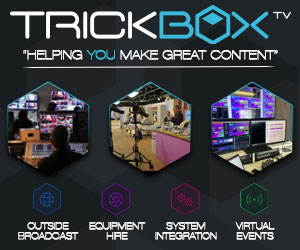Broadcast News
07/05/2013
Big Interview: ATG Broadcast

ATG Broadcast this year celebrates its 20th anniversary as a successful broadcast systems integrator. The company offers a wide range of services including workflow design, project planning, equipment installation, software configuration, commissioning, documentation and on-site training.
ATG Broadcast pioneered the transition from video tape to the file-based technology now used throughout the industry. It has also assisted many clients in the construction of new high-definition studios, master control rooms and playout facilities, as well as the upgrade of existing SD systems to HD.
RFV spoke to Tim Felstead, Head of Sales & Marketing, about the company's past, present and future.
RFV: ATG Broadcast has a long history of innovation. Has broadcast technology reached maturity or will the present rate of development continue?
The media business is not a straightforward industry where each technical advance replaces its predecessor. The printed word, recorded sound, cinema, radio, television, home computing, each has survived and continues to develop in healthy competition. Within the television sector, we see five main engines of change:
First, the pressure from display manufacturers to maintain profits at a time when sales of 1920 x 1080 screens are approaching saturation.
Second, the need for subscription television networks to offer services not available from free-to-air or license-funded broadcast channels.
Third, the reciprocal need for national channels not to get left behind.
Fourth, the ever increasing power of computer-based technology.
And fifth, the public appetite for bigger, better, more convenient media consumption methods. Far from reaching maturity, the rate of technical progress is accelerating.
What does ATG Broadcast see as the most significant technical driver in the current market?
The current main delivery system driver, and the major expense, is the demand for additional high definition channels to match the expectations of viewers as they invest in larger display screens. However, the most difficult technical challenge comes from the coupling of adaptive-bit-rate delivery methods and the re-engineering of internal systems for business processes connected with file-based content management. ATG has built up a large skill-set in this field.
Do you see a serious future for 3D?
3D is going to remain something of an option for owners of media in the future. Yes, it will form part of the spectrum made available to consumers but, in terms of the whole media business arena, it will remain as it has always been: a small component, even if high profile. Having said that, ignore 3D at your peril, in the same way that ignoring consumption on portable devices would be similar folly in today's market.
And 4K?
We have not yet been asked to quote for a 4K system but are well prepared to meet the demand as or when it arises. 4K has a lot to offer as a production format, allowing a producer to select essentially 2K content from a live or recorded 4K source. Whether consumers will want to invest in the 2 metre high displays made possible by 4K is yet to be proved. But remember that 4K also has potential for retina-quality near-screen viewing.
Given the growing importance of server-based content management, how does ATG view the question of file format compatibility?
Progress in signal encoding and metadata management will inevitably lead to more rather than fewer video and audio files formats in the future. Just as advances into tape technology fueled format wars, so there will always be a need to handle multiple file formats and wrapper types. Broadcast systems integration increasingly demands a thorough understanding of software issues, not just in terms of the signals going through but the infrastructure itself, the demands on network design and capacity and the machines required to process at intermediate stages.
Does ATG see the television business itself changing in line with technical progress?
Service-oriented architecture will have a massive impact on the broadcast industry. Everything from rights management to linear automated playout will be far more interoperative and connected in future. This is a period of great change and innovation. Some areas will remain familiar and develop less quickly. Live programme production will maintain a familiar technical infrastructure. It is unlikely that time criticality will shift far from current baseband system structures. Similarly linear channel delivery will maintain a familiar architecture for a few years, at least in the final output stage.
Has the role of the systems integrator change significantly in recent years?
The transition to file-based operation encouraged greater dialogue with our clients' operational staff than in the days of discrete media. The skills deployed by systems integrators have necessarily become much more focused on information technology and on the operational workflow. This was a positive move for everyone involved. Another key development is that timescales have become much shorter than used to be the case. For this reason, world-class project management has become essential.
A major concern is to ensure that the systems selected are up to the demands of round-the-clock operation with all that that entails. A vital issue for the systems integrator is to ensure that third-party equipment interfaces efficiently into the central control system, up to and including an enterprise-wide media asset management system. Different workflow processes between one sub-installation and another have to be handled carefully to ensure operational efficiency between subsystems. Taking responsibility for such systems’ design and process control is now far more operationally critical than in days of old. The role of the SI has changed massively from ‘design, deliver, leave’ to ‘consult, design, deliver, train and partner to re-consult’; a much longer cycle and client relationship.
Read the article in the online edition of Regional Film & Video here.
(IT/CD)
ATG Broadcast pioneered the transition from video tape to the file-based technology now used throughout the industry. It has also assisted many clients in the construction of new high-definition studios, master control rooms and playout facilities, as well as the upgrade of existing SD systems to HD.
RFV spoke to Tim Felstead, Head of Sales & Marketing, about the company's past, present and future.
RFV: ATG Broadcast has a long history of innovation. Has broadcast technology reached maturity or will the present rate of development continue?
The media business is not a straightforward industry where each technical advance replaces its predecessor. The printed word, recorded sound, cinema, radio, television, home computing, each has survived and continues to develop in healthy competition. Within the television sector, we see five main engines of change:
First, the pressure from display manufacturers to maintain profits at a time when sales of 1920 x 1080 screens are approaching saturation.
Second, the need for subscription television networks to offer services not available from free-to-air or license-funded broadcast channels.
Third, the reciprocal need for national channels not to get left behind.
Fourth, the ever increasing power of computer-based technology.
And fifth, the public appetite for bigger, better, more convenient media consumption methods. Far from reaching maturity, the rate of technical progress is accelerating.
What does ATG Broadcast see as the most significant technical driver in the current market?
The current main delivery system driver, and the major expense, is the demand for additional high definition channels to match the expectations of viewers as they invest in larger display screens. However, the most difficult technical challenge comes from the coupling of adaptive-bit-rate delivery methods and the re-engineering of internal systems for business processes connected with file-based content management. ATG has built up a large skill-set in this field.
Do you see a serious future for 3D?
3D is going to remain something of an option for owners of media in the future. Yes, it will form part of the spectrum made available to consumers but, in terms of the whole media business arena, it will remain as it has always been: a small component, even if high profile. Having said that, ignore 3D at your peril, in the same way that ignoring consumption on portable devices would be similar folly in today's market.
And 4K?
We have not yet been asked to quote for a 4K system but are well prepared to meet the demand as or when it arises. 4K has a lot to offer as a production format, allowing a producer to select essentially 2K content from a live or recorded 4K source. Whether consumers will want to invest in the 2 metre high displays made possible by 4K is yet to be proved. But remember that 4K also has potential for retina-quality near-screen viewing.
Given the growing importance of server-based content management, how does ATG view the question of file format compatibility?
Progress in signal encoding and metadata management will inevitably lead to more rather than fewer video and audio files formats in the future. Just as advances into tape technology fueled format wars, so there will always be a need to handle multiple file formats and wrapper types. Broadcast systems integration increasingly demands a thorough understanding of software issues, not just in terms of the signals going through but the infrastructure itself, the demands on network design and capacity and the machines required to process at intermediate stages.
Does ATG see the television business itself changing in line with technical progress?
Service-oriented architecture will have a massive impact on the broadcast industry. Everything from rights management to linear automated playout will be far more interoperative and connected in future. This is a period of great change and innovation. Some areas will remain familiar and develop less quickly. Live programme production will maintain a familiar technical infrastructure. It is unlikely that time criticality will shift far from current baseband system structures. Similarly linear channel delivery will maintain a familiar architecture for a few years, at least in the final output stage.
Has the role of the systems integrator change significantly in recent years?
The transition to file-based operation encouraged greater dialogue with our clients' operational staff than in the days of discrete media. The skills deployed by systems integrators have necessarily become much more focused on information technology and on the operational workflow. This was a positive move for everyone involved. Another key development is that timescales have become much shorter than used to be the case. For this reason, world-class project management has become essential.
A major concern is to ensure that the systems selected are up to the demands of round-the-clock operation with all that that entails. A vital issue for the systems integrator is to ensure that third-party equipment interfaces efficiently into the central control system, up to and including an enterprise-wide media asset management system. Different workflow processes between one sub-installation and another have to be handled carefully to ensure operational efficiency between subsystems. Taking responsibility for such systems’ design and process control is now far more operationally critical than in days of old. The role of the SI has changed massively from ‘design, deliver, leave’ to ‘consult, design, deliver, train and partner to re-consult’; a much longer cycle and client relationship.
Read the article in the online edition of Regional Film & Video here.
(IT/CD)
Top Related Stories
Click here for the latest broadcast news stories.
04/03/2013
ATG Broadcast To Promote Its Broadcast Systems
ATG Broadcast returns to the Dubai World Trade Centre in March, promoting its all-embracing range of broadcast systems planning, design, installation,
ATG Broadcast To Promote Its Broadcast Systems
ATG Broadcast returns to the Dubai World Trade Centre in March, promoting its all-embracing range of broadcast systems planning, design, installation,
12/12/2008
ATG Broadcast Celebrates 15 Years Of Success In Broadcast Systems Integration
Leading systems integrator ATG Broadcast is celebrating its 15th anniversary with the production of a brochure outlining some of the many contracts wo
ATG Broadcast Celebrates 15 Years Of Success In Broadcast Systems Integration
Leading systems integrator ATG Broadcast is celebrating its 15th anniversary with the production of a brochure outlining some of the many contracts wo
18/08/2006
ATG Broadcast joins Danmon Systems Group
UK-based international system integrator ATG Broadcast Ltd announces its acquisition by Danmon Systems A/S as a wholly-owned subsidiary. Scandinavia's
ATG Broadcast joins Danmon Systems Group
UK-based international system integrator ATG Broadcast Ltd announces its acquisition by Danmon Systems A/S as a wholly-owned subsidiary. Scandinavia's
04/09/2001
ATG SPECTRUM CHANGE NAME TO ATG BROADCAST
AS PART of a new corporate structure, broadcast systems integrators ATG Spectrum are to be rebranded as ATG Broadcast. Graham Buchanan, Managing Direc
ATG SPECTRUM CHANGE NAME TO ATG BROADCAST
AS PART of a new corporate structure, broadcast systems integrators ATG Spectrum are to be rebranded as ATG Broadcast. Graham Buchanan, Managing Direc
05/07/2001
ATG SPECTRUM RE-BRANDS AS ATG BROADCAST
OVER the summer in the run up to IBC, ATG Spectrum will adopt a new name and a new logo. As part of a new corporate structure, broadcast systems integ
ATG SPECTRUM RE-BRANDS AS ATG BROADCAST
OVER the summer in the run up to IBC, ATG Spectrum will adopt a new name and a new logo. As part of a new corporate structure, broadcast systems integ
04/07/2016
Broadcast Wireless Systems To Unveil New Codec Platform Broadcast
Wireless Systems has announced that it will unveil its plans for a new H.265/4K video codec platform at IBC 2016. Broadcast Wireless will also demonst
Broadcast Wireless Systems To Unveil New Codec Platform Broadcast
Wireless Systems has announced that it will unveil its plans for a new H.265/4K video codec platform at IBC 2016. Broadcast Wireless will also demonst
09/05/2012
Broadcast Asia 2012 Preview: ATG Broadcast
ATG Broadcast will promote its full range of systems planning, design, installation, commissioning and post-installation support services at Broadcast
Broadcast Asia 2012 Preview: ATG Broadcast
ATG Broadcast will promote its full range of systems planning, design, installation, commissioning and post-installation support services at Broadcast
16/05/2011
ATG Broadcast Announce Broadcast Asia 2011 Preview
ATG Broadcast will exhibit its full range of systems planning, design, installation, commissioning and post-installation, support services at Stand 4R
ATG Broadcast Announce Broadcast Asia 2011 Preview
ATG Broadcast will exhibit its full range of systems planning, design, installation, commissioning and post-installation, support services at Stand 4R
06/05/2009
Broadcast Asia In Focus For ATG Broadcast
A supplier of broadcast systems planning, design, installation, commissioning and post-installation support services, ATG Broadcast, will be exhibitin
Broadcast Asia In Focus For ATG Broadcast
A supplier of broadcast systems planning, design, installation, commissioning and post-installation support services, ATG Broadcast, will be exhibitin
09/10/2003
ATG Broadcast to create production village for BBC Broadcast
One of Europe's leading systems integrators, ATG Broadcast, has been selected to design and build a fully digital production village within BBC Broadc
ATG Broadcast to create production village for BBC Broadcast
One of Europe's leading systems integrators, ATG Broadcast, has been selected to design and build a fully digital production village within BBC Broadc
25/11/2019
Videosys Broadcast Supplies 4K Digital Transmitter Systems To Cloudbass
Videosys Broadcast has supplied two DTC 4K AEON-CC digital video transmitter systems to Cloudbass, a leading provider of broadcast solutions. Specific
Videosys Broadcast Supplies 4K Digital Transmitter Systems To Cloudbass
Videosys Broadcast has supplied two DTC 4K AEON-CC digital video transmitter systems to Cloudbass, a leading provider of broadcast solutions. Specific
27/10/2017
Broadcast RF Orders HEVC 4K UHD HCAM Wireless Camera Systems
xG Technology(xG) has announced that its Vislink business has received an order worth $400,000 for 10 HEVC (High Efficiency Video Coding) 4K UHD HCAM
Broadcast RF Orders HEVC 4K UHD HCAM Wireless Camera Systems
xG Technology(xG) has announced that its Vislink business has received an order worth $400,000 for 10 HEVC (High Efficiency Video Coding) 4K UHD HCAM
02/10/2015
RT Software To Utilise AJA Corvid 88 For 4K Broadcast Graphics Systems
RT Software has announced it will use AJA Video Systems' Corvid 88 video card in its 4K real-time broadcast graphics systems. In addition, the develop
RT Software To Utilise AJA Corvid 88 For 4K Broadcast Graphics Systems
RT Software has announced it will use AJA Video Systems' Corvid 88 video card in its 4K real-time broadcast graphics systems. In addition, the develop
08/11/2022
ATG Danmon Completes Media Systems Integration Project
ATG Danmon has completed a large-scale media systems integration project for a leading UK university. The new resource is designed and equipped to sup
ATG Danmon Completes Media Systems Integration Project
ATG Danmon has completed a large-scale media systems integration project for a leading UK university. The new resource is designed and equipped to sup
25/04/2022
ATG Danmon To Unveil Full Range Of Systems Integration Services
ATG Danmon is to promote its full range of systems integration services on stand T3 at the Media Production & Technology Show, Olympia London, Wednesd
ATG Danmon To Unveil Full Range Of Systems Integration Services
ATG Danmon is to promote its full range of systems integration services on stand T3 at the Media Production & Technology Show, Olympia London, Wednesd















